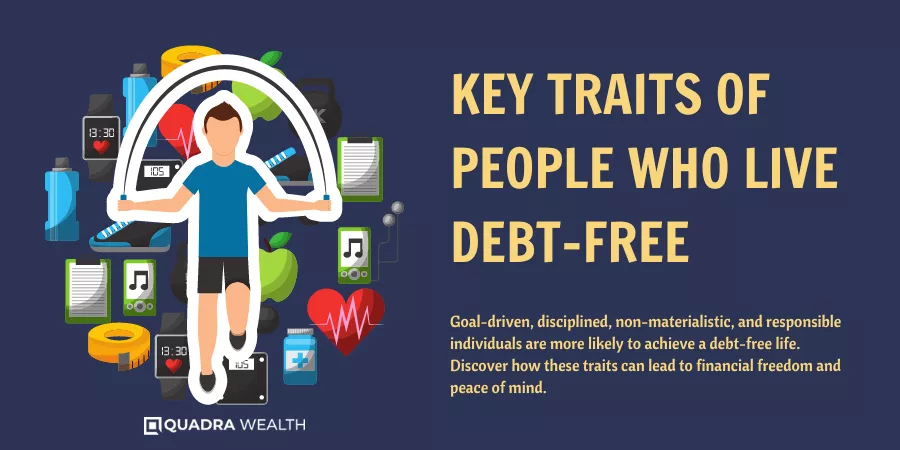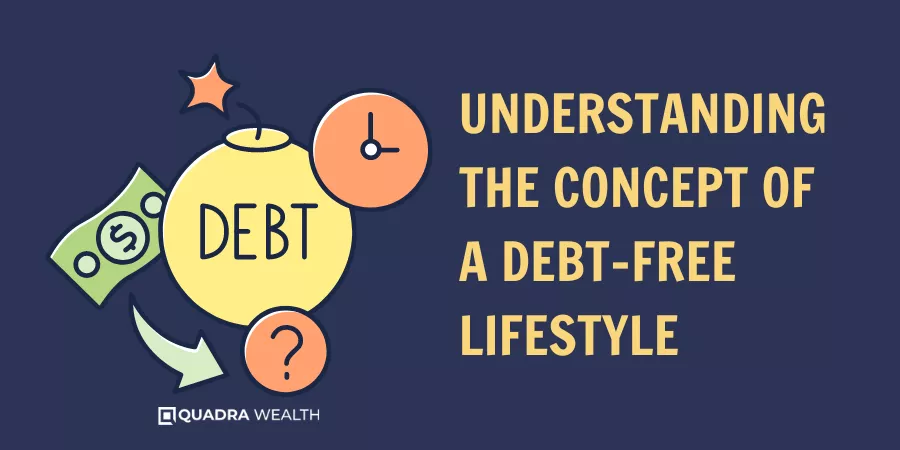Are you tired of the constant worry and stress that debt brings? According to Experian data, in 2021, the average American’s debt balance was a staggering $96,371. This blog will guide you through various practical strategies toward achieving a debt-free life.
Let’s embark on this journey to financial freedom together!
Key takeaways
● Living a debt-free life means you owe no money and have control over your finances, allowing you to spend money how you like.
● People who live without debt experience enhanced mindset and confidence, financial stability and freedom, and reduced stress with increased peace of mind.
● Key traits of people who live in debt relief include being goal-driven, disciplined, non-materialistic, and responsible with their finances.
● To achieve a debt-free life, identify and understand your debts, create a feasible repayment strategy, develop a budget, and cultivate positive money habits.
Understanding the Concept of a Debt-Free Lifestyle
Living debt-free means you owe no money. You don’t have to pay bills for personal loans, credit card debt, or mortgages. This lifestyle gives you control over your money. You can spend it how you like, not on paying off what you owe.
It’s good because it brings peace and debt freedom.
There are different ways people live without debt. Some use a debt snowball method. Others prefer the debt avalanche way. Both plans help to clear debts fast and let people live free of owing money sooner.
The average consumer in the US owes $96,371 says Experian data. Sadly, many see living with this burden as normal life.
Without this weight though, there is more chance to do things we love and less worry about finding cash for unpaid dues.
Getting rid of discretionary spending and creating a budget are key steps in this lifestyle change.
Firstly spot where all your fund goes.
Then cut out needless spending from your daily life.
Lastly, make sure you keep track of your cash so that it doesn’t run out before the next paycheck comes in.
This may seem hard but following these steps can lead one towards a life free from financial stress provided by unnecessary debts!
The Benefits of Living Without Debt
Living without debt offers many benefits, including an enhanced mindset and confidence, financial health and freedom, and reduced stress with increased peace of mind.

Enhanced mindset and confidence
Living completely debt free gives your mind a fresh start. It lets you see things in a new light. You begin to think more about how to save funds and less about how to pay off debts. This new way of thinking makes you more confident.
You feel strong because you have control of your financial life.
You also start setting goals for saving and spending money. You no longer need to worry about the monthly payment. Your worries become dreams as your mind starts financial planning for the future instead of worrying about the past.
Financial stability and freedom
Living debt-free brings financial stability and freedom. People who owe nothing have more control over their money. They choose how and when to spend it. With no debt, an increase in the average debt balance does not scare them.
This freedom allows them to plan for fun things like travel or gifts, without stress. It also helps them save for big goals like buying a house or starting a business. Being free from debt makes life much easier and happier.
Reduced stress and increased peace of mind
Less debt means less worry. Living without debt brings calmness to your mind. You don’t need to stress about paying bills or where the funds will come from for living costs. This peace of mind makes you happier and healthier too.
It also helps you make clear decisions because you are not under pressure about money problems.
- Stress & Worry
- High Interest
- Limited Freedom
- Bankruptcy Risk
- Credit Impact
- Lost Opportunities
- Strained Relations
- Peace & Security
- Financial Freedom
- Less Stress
- More Savings
- Strong Credit
- Better Relationships
- Stability
Key Traits of People Who Live Debt-Free
Goal-driven, disciplined, non-materialistic, and responsible individuals are more likely to achieve a debt-free life. Discover how these traits can lead to financial freedom and peace of mind.

Goal-driven
Being goal-driven plays a big part in living debt-free. People with this trait know what they want and aim to get it. They create a clear plan for their money needs. This allows them to use their funds wisely and avoid slipping into debt.
A good example is setting the goal of becoming debt-free within a year. To meet this target, one must make real changes to how they handle cash flow. You might need to cut back on extra cash spending or take up new ways of making extra income.
In doing so, you gain control over your personal finance situation and pave your way towards financial freedom.
Disciplined
People who live debt-free show a lot of self-control. They stick to their plans and do not give up easily. Not buying items on a whim is part of being disciplined. They are strong enough to say no when they want something but don’t need it.
This trait helps them save cash and avoid new debt.
Non-materialistic
People with no debt care less about having a lot of stuff. They do not let things control their lives. This way, they feel more free and happy. They know that fancy cars or big houses don’t make life better.
The joy in life comes from who we are, not what we have. So, they use the money for their financial needs, not wants. This helps them live without debt and keep financial peace.
Responsible
People who live debt-free are known for their responsible behavior when it comes to their finances. They take ownership of their financial decisions and prioritize living within their means.
Responsible individuals understand the importance of budgeting, tracking expenses, and making wise spending choices. They avoid impulse purchases and make thoughtful decisions about what they truly need versus what they want.
By being responsible with their money, debt-free individuals can achieve financial stability and peace of mind.
Steps to Achieving a Debt-Free Life
To achieve a debt-free life, you need to identify and understand your debt, create a feasible repayment strategy, develop a budget, and cultivate positive money habits.

Identifying and understanding your debt
To start your journey towards a debt-free life, the first step is to identify and understand your debt. Take a look at all the funds you owe, including credit card balances, student loan debt, and any other outstanding personal loans.
Knowing the exact amount of your debt will help you create a realistic plan to pay it off. Additionally, it’s important to understand the interest rates associated with each debt. This information will guide you in prioritizing which debts to tackle first.
By facing your debts head-on and gathering this important information, you’re laying the foundation for a successful journey toward financial security and freedom.
Creating a feasible repayment strategy
To create a feasible repayment strategy, start by identifying and understanding your debt. Take the time to gather all the information about your debts, including balances, interest rates, and minimum payments.
Then, evaluate your current financial situation to determine how much extra money you can allocate towards paying off debt each month. This could involve cutting back on discretionary spending or finding ways to increase your income.
Once you have a clear picture of your debts and available funds, prioritize them based on factors like interest rate or emotional significance. There are different strategies you can use depending on your goals and preferences, such as the popular debt snowball method where you focus on paying off smaller debts first for quick wins, or the debt avalanche method where you target high-interest debts first to save more money in the long run.

Developing a budget and sticking to it
Developing a budget and sticking to it is an essential step in achieving a debt-free lifestyle. By creating a budget, you can track your income and expenses to ensure that you are spending within your means.
Start by identifying your sources of income and listing all your necessary expenses, such as rent or mortgage payments, utilities, groceries, and transportation costs. Then allocate a specific amount for discretionary spending.
Sticking to this budget requires discipline and self-control. It may involve making sacrifices and cutting back on unnecessary expenses. However, by following your budget consistently, you can avoid overspending, reduce debt accumulation, and work towards financial stability.
Consider the services offered
When choosing a flat-fee financial advisor, it’s important to consider the services they offer. Some advisors may only provide a financial plan, while others also offer investment management advisory services.
It’s crucial to understand what is included in the fee and determine if their services align with your needs. For example, if you require ongoing investment management and planning for retirement, you’ll want to find an advisor who offers these services as part of their flat fee package.
Additionally, some advisors may specialize in certain areas such as taxes or estate planning, so be sure to choose one that can address your specific financial goals. By carefully considering the interest by different fee only advisors, you can find the right advisor who can meet your unique needs.
Cultivating positive money habits
Cultivating positive money habits is essential for achieving and maintaining a debt-free lifestyle. By developing good financial behaviors, individuals can effectively manage their money and avoid unnecessary debts.
One important habit is creating and sticking to a budget. This helps to track income and expenses, prioritize your spending habits, and save for future financial goals. Another crucial habit is practicing self-control when it comes to impulse purchases.
By resisting the urge to buy unnecessary items, individuals can avoid accumulating debt unnecessarily. Additionally, consistently saving a portion of income each month builds an emergency fund that provides a safety net in case unexpected expenses arise.
If you follow these guidelines, you may be able to lower your debt and reduce your financial stress.
You can try different techniques to help too. For instance, you can look into debt consolidation loans or balance transfers to help refinance and pay off your debts at a lower interest rate.
Conclusion
In conclusion, living a debt-free life is definitely possible with the right mindset and dedication. It may require making sacrifices and developing good money habits, but the benefits are worth it.
By understanding your debts, creating a repayment strategy, and sticking to a budget, you can achieve financial stability and enjoy the peace of mind that comes with being debt-free.
So go ahead, take control of your finances, and embrace a debt-free lifestyle!
FAQs
Yes, it is possible to live a debt-free life if you live within your means, avoid borrowing money, and pay off any existing debts in full.
To avoid debt, you can create a budget, spend less than you earn, have an emergency fund, and only buy what you can afford with cash or debit cards.
Living a debt-free life gives you financial freedom and peace of mind. You won’t have to worry about interest payments or mounting debts, and you’ll have more money available for saving and investing in your future financial goals.
Yes, it is possible to become zero debt even if you already have debts. By creating a repayment plan, prioritizing debt payments towards high-interest debt first, and seeking professional advice if needed; you can gradually pay off your debts over time and achieve a debt-free life.











